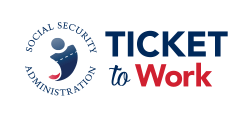Choosing a Service Delivery Model
Title 1 of the Rehabilitation Act of 1973 and its governing regulations allow State Vocational Rehabilitation (VR) agencies some flexibility in developing a State Plan for VR services. Each State Plan must address all Federal requirements while considering the service delivery system and characteristics of the population of individuals with disabilities in the state. The purpose of the State Plan is to spell out the agency's annual goals and objectives and plans to implement pilots and initiatives for specific disability groups or service sectors. With the ability to choose between serving Ticketholders under the Cost Reimbursement (CR) program or the Ticket Program, State VR agencies often look at historical data prior to choosing a service delivery model for this population. Below are some of the factors that VR agencies consider:
Ticketholder Interests/Needs
- What percentage express an interest in working full-time and ending their disability cash benefits? In working part-time and remaining on disability benefits?
- What percentage are likely to achieve nine months of earnings at the Substantial Gainful Activity (SGA) level?
- What types of services do beneficiaries typically need? What are the projected costs of those services?
- What percentage are likely to need long-term support after job placement?
Administrative Considerations
- Does the agency have an automated system for administering CR claims?
- Does the agency have the ability to continue providing services for multiple years after VR case closure?
- Does a cost comparison indicate that more revenue will be generated if certain beneficiaries (e.g., those with minimal service needs) are served under the Ticket Program?
- Are VR's annual goals for program income best met by serving all beneficiaries under the CR program or by choosing between serving beneficiaries under the CR or the Ticket Program on a case-by-case basis?
Staffing
- Is there a full-time or part-time CR/Ticket Coordinator at the state level who handles administrative tasks associated with the CR and/or the Ticket Program? Is this person responsible for developing formal/informal referral mechanisms and negotiating interagency agreements?
Note: There is evidence that State VR agencies benefiting most from partnership models are those that have at least one full-time person responsible for CR and/or Ticket-related activities. - Are information technology or other technical staff responsible for producing the electronic files necessary to move Tickets in/ out of the In-Use SVR status and/or to assign/unassign Tickets?
- What is the VR Counselor's (VRC) role in informing Ticketholders about their options under the Ticket Program and encouraging them to assign their Tickets to ENs after case closure?
Note: VRCs should discuss the Ticket Program as one option for accessing ongoing support after case closure and, as appropriate, as an alternative to being placed on a wait-list for VR services. VRCs should have understanding of the Ticket Program and tools (e.g., brochures, fact sheets, referral forms, etc.) to advise beneficiaries about their options and then facilitate referrals to ENs after case closure.
Programmatic Strengths
- Does the State VR agency have a successful history of partnering with other organizations to improve employment outcomes for individuals with disabilities?
- Are there effective interagency agreements, special programs, or initiatives in the state that promote employment for significant numbers of Ticketholders?
- Do certain ENs or VR contractors demonstrate success in placing Ticketholders in jobs that pay at or above the SGA level?
- Do ENs/VR contractors serving the state have demonstrated success in providing on-going supports after job placement?
Resource Issues
- Is the agency able to serve all Ticketholders seeking assistance or is an Order of Selection (OOS) in place to prioritize services for individuals with the most significant disabilities first?
- When OOS is implemented, are Ticketholders wait-listed for services? Is assigning the Ticket to an EN discussed with Ticketholders being wait-listed?
- Can Ticketholders access benefits planning assistance through VR agency staff, referrals to the local Work Incentives Planning and Assistance (WIPA) project, or other organizations with certified benefits planners? Are these resources adequate to meet the needs of all Ticketholders served by VR?

